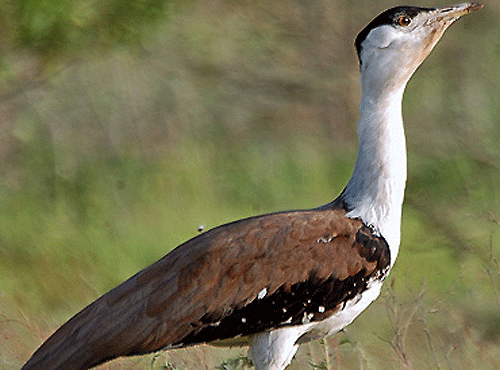One of the world’s largest species of bird – the great Indian bustard (GIB) –is on the brink of extinction with around 200-odd surviving in the wild.
According to Kedar Gore, the Director of The Corbett Foundation, which is engaged in conversation of GIBs, the situation is alarming. “This is perhaps the last call, if we do not do anything now, the entire species would be lost,” Gore told Deccan Herald on Monday, adding that the Ministry of Environment and Forests (MoEF) need to take urgent steps to ensure that the GIBs are not extinct.
The Indian bustard or great Indian bustard (Ardeotis nigriceps) lives in short-grass plains and deserts in large arid landscapes. It is now confined to only eight pockets in 6 Indian states — Rajasthan, Gujarat, Maharashtra, Madhya Pradesh, Karnataka and Andhra Pradesh.
The largest population of about 100 birds can be found in Jaisalmer, Barmer, and Bikaner districts of Rajasthan where it is the state bird. Remaining populations number less than 30 birds each.
“In Maharashtra, we have reports that only two are left. It may be already extinct in Madhya Pradesh,” Gore said.
Couple of months ago, during an interview with Deccan Herald, Dr M K Ranjitsinh, the first Director of Wildlife Preservation of India and the member secretary of the task force that formulated the Project Tiger, too had expressed concern over the falling numbers of GIBs.
GIBs figure in the International Union of Conservation of Nature's (IUCN) “Red List of Threatened Species for Birds”. The population estimates reveal an estimated population of less than 30 birds in Kutch out of the total 200-odd birds surviving in the wild today.
The Indian bustard shares its habitat with other species of the bustard family – MacQueen’s Bustard (Chlamydotis macqueeni) and Lesser Florican (Spheotides indica), both vulnerable and endangered respectively as per the IUCN Red List.
“It is extremely essential to stop and remove the encroachment from the important areas for GIB. Industrial projects cannot be sanctioned on the land used by Indian Bustards,” Gore said.
The BNHS-India has been working for bustard conservation for over a decade across India. 8As a matter of fact, Dr Asad Rahmani, Director, BNHS-India, who is the foremost authority on GIBs, had earlier demanded an urgent need to start Project Bustard on a long term basis, based on scientific recommendations of studies conducted by BNHS and other organisations.
